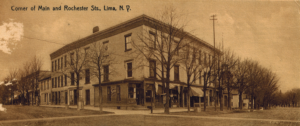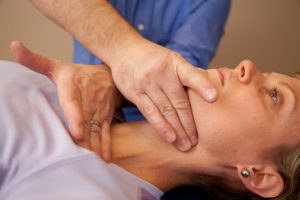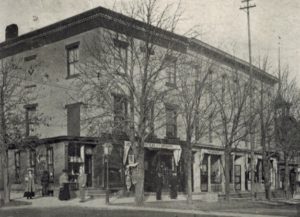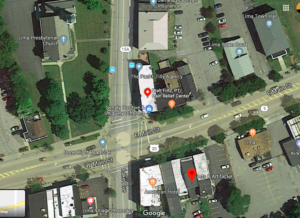Are pain and movement problems keeping you from enjoying life? If so, Walt Fritz, PT at the Pain Relief Center, might be able to help.
As a physical therapist (PT), I see the value in movement as a means to stay healthy and restore function. However, movement takes many forms. The traditional PT view of movement is typically formalized exercise under the guise of strengthening. “We need to make you stronger so that you have better stability,” and other phrases are often used to explain this belief. Such descriptions are often popular beliefs on pain and movement disorders but are woefully simplistic. While strengthening can sometimes reduce pain, the mechanisms of exercise are complex.
I use manual therapy (think a slow, sustained stretch or pressure) to improve pain and the ability to move with fewer problems. When pain is lessened, movement (exercise) can often return on its own. We regularly discuss movement and exercise options throughout your treatment.
I’ve used manual therapy as my primary intervention for decades now. While I have recently moved on from calling what I use in my PT practice and what I teach health professionals myofascial release, I continue to use that gentle, sustained stretch style in my practice. The reason for moving on from that description involves the limited credibility of the background science to support myofascial release. If you are interested, these and other issues surrounding my updated explanations can be discussed during your session.
My approach to physical therapy is to address areas that concern you the most or that are most limiting to you through manual therapy work. Then, we try to craft a movement program that, along with home self-stretching strategies, improves your quality of life.
Walt Fritz, PT
Walt often gets referrals as the MFR (myofascial release) expert in the Rochester area. He wore that badge for years but has now moved on from it. Why the change? Though the hands-on work called MFR is helpful, nearly all of the explanations for restricted (stuck) fascia and scar tissue are unsubstantiated, as are the stories on how a therapist can select fascia (or any other tissue) for treatment to the exclusion of all other tissues. Walt continues to use the hands-on work he’s used for years, including when he considered himself an MFR expert, but now with well-rounded neurologically-based explanations for problems and possible solutions.
Walt Fritz, PT (Pain Relief Center) is in Lima, NY. Where is Lima located? Imagine Route 5/20. Got it? Now think about Rt. 15 (East Henrietta Rd). Where those two roads meet is the 4-corners in Lima, known as The Crossroads of Western New York. Just how far is Lima? If you’ve been to Honeoye Falls, you are just 3 miles from Lima. The office is 4 miles east of the Avon/Lima exit (#10) off 390 South.
On-street parking is available directly in front of the office on both Main St. (Rt. 20/5) and Rochester St. (Rt. 15A). Off-street parking is also available in the municipal parking lot just east of the 4-corners on the north side of Main St. (Rt. 20/5). The office is accessed via the side door on Rochester St.
Walt Fritz, PT, is a New York State Licensed physical therapist with over 40 years of experience and has been helping others get out of pain and get on with their lives for years. The goal of treatment is to create positive, lasting changes. Isn’t it time you visited the Pain Relief Center? He splits his time seeing patients in Lima and teaching health care professionals worldwide.
I invite you to spend some time reading through the various pages here. You will see a bit of yourself mentioned. Then make a call or email us to see what we can do for you.
What is treatment like at the Pain Relief Center?
Unlike what many view as “traditional” physical therapy, Walt Fritz utilizes manual therapy combined with movement recommendations as his primary intervention. This approach relies on a therapeutic alliance between himself and the patient to best determine intervention. You will find this approach refreshing, as you will be wholly included in the evaluation and treatment planning process to a level and degree that you’ve never experienced. Unlike many physical therapy practices, you will have Walt Fritz, PT’s undivided attention throughout every session, without passing you off to an assistant or aide for treatment.
Your first session begins with a complete history gathering and a thorough evaluation. All first sessions also include some treatment, so you will get the chance to experience what makes physical therapy at the Pain Relief Center unique.
Traditional physical therapy often stresses a “weakness” model for pain treatment, where you are given specific strengthening exercises based on what is said to be weak. The theory is that the pain will diminish if you can better support yourself. While exercise is often helpful, claiming that the cause is weakness is too narrow a view of a complex problem. Physical therapy at the Pain Relief Center is quite different, as we use manual therapy approaches coupled with novel forms of movement to help get you back into action. Whether it is for issues of pain or problems moving, the approach taken by Walt Fritz is often a fresh start. We use an evidence-based approach to physical therapy customized to each individual’s needs.
Walt Fritz is an internationally recognized educator and teaches his form of manual therapy to physical therapists, speech-language pathologists, massage therapists, occupational therapists, and others. You can read more about his teaching at this link. By using an approach based on a more accurate range of explanations, Walt utilizes best-practice approaches to pain and movement disorders. He will work with your physician to best serve your needs. If you have heard of Walt’s experience using myofascial release (MFR), due to some significant issues of credibility of the underlying explanation used in most MFR therapies, Walt has evolved his practice into a simpler version, manual therapy.
A doctor’s prescription or referral is unnecessary before your first appointment at the Pain Relief Center (though we will need one shortly after), and scheduling an appointment is easy; click on the “Book Now” link on the right-hand side of this page or call us at 585-244-6180.
Payment and Insurance Guidelines
The Pain Relief Center is In-Network with Aetna, TriCare, Independent Health, Medicare, Preferred Care GOLD, and No-Fault (Motor Vehicle) as In-Network insurance. All insurance-based sessions typically run 40 to 50 minutes.
All other insurances, including Excellus BCBS, Cigna, United Health Care, and traditional MVP, would be considered Out-of-Network (OON). In-network (INN) coverage allows you to pay a co-pay or co-insurance after any appropriate deductible. Your insurer pays the rest directly to the provider (the Pain Relief Center). If we do not accept your insurance, you may receive reimbursement for some session fees if your policy covers OON physical therapy. We can check with your insurer if your policy includes out-of-network benefits. We do not accept Medicaid or Workman’s Compensation policies.
The private pay rate for sessions at the Pain Relief Center is $65.00 for the standard 25-minute session or $130.00 for the extended 50-minute session. When assessing out-of-pocket costs, please remember that you will have Walt Fritz, PT’s undivided attention throughout each session. Unlike traditional physical therapy, where most patients exercise on their own with occasional supervision from the physical therapist, treatment at the Pain Relief Center will keep you engaged throughout the entire session with Walt.
A few things to understand: an OON deductible must often be met before you receive money back for your session fees. At times, this deductible is separate from your In-Network deductible. It is best to call your insurer directly to ask if this applies. OON physical therapy is charged at the private pay rate of $ 65/per 25-minute session or $130/per 50-minute session. Please understand that your insurer will reimburse you based on their maximum daily rate for physical therapy reimbursement, which is different from the per-session fee collected here.
Payment for all treatment may be made by HSA cards, Flex-Spending cards, credit/debit cards, checks, or cash.
Why would I consider seeing a PT who does not accept my insurance?
While paying out-of-pocket may seem out of the question, you will find that sessions are affordable and often priced only slightly higher than your copayment would cost at other PT clinics. Why pay out-of-pocket when you can see an in-network PT at another clinic? Walt Fritz uses a unique method of manual therapy that often helps where traditional exercise-based PT does not. Plus, Walt works with you throughout the entire session, which is very unlike conventional clinic-based PT.
Understanding Out-of-Network Services
Many insurance companies allow you to see an out-of-network (OON) physical therapist. Unsure if you have out-of-network benefits? Here is a general guideline:
PPO (Preferred Provider Organization): Has out-of-network benefits
Indemnity: Typically, has out-of-network benefits
POS (Point of Service): May have some out-of-network benefits
HMO (Health Management Organization): No out-of-network benefits
When seeing a physical therapist for OON services, understanding the math helps guide your treatment choices. The Pain Relief Center will contact your insurer to determine if you have OON coverage. Payment of the OON fee is due at the time of each visit. The OON fee at the Pain Relief Center is $130/50-minute (standard) session and $65/25-minute session. Your visit billing notes will be submitted to your insurer by us, who will then reimburse you for the allowable amount under your OON contract details. It is essential to understand that many insurers cap session fees at a rate below (sometimes far below) what you are paying for that OON PT session. For example, one major insurer allows $92.50 for the initial evaluation session and $65 for all subsequent follow-up sessions, which applies to most OON plans. If your co-payment is found to be, for example, $35, your probable reimbursement for the initial PT evaluation session would be $92.50 – $35 = $56.50 reimbursement for all follow-up sessions: $65 – $35 = $30 reimbursement. If you have a deductible, no money will be reimbursed until the annual deductible is met.
We do not guarantee reimbursements by your insurer, as individual policy nuances make the exact determination of those reimbursements uncertain. Please contact your insurance company to speak about OON coverage for further details.
How much time does/did your current/past PT spend with you during a session?
Unlike traditional physical therapy session, where the PT (or assistant) splits their time between you and other patients, Walt’s model of manual therapy guarantees that you will have his undivided attention during the entire session. While exercise-based models of PT can certainly be effective, many patients fall through the cracks in this sort of approach and may benefit more from a manual therapy style of intervention.
Treatment for full-body problems, as well as voice and swallowing disorders
Walt treats head-to-toe conditions of pain and movement difficulty. He is the most experienced therapist utilizing a manual therapy style of treatment in the entire Western New York region. Additionally, given Walt’s expertise in teaching his work to speech-language pathologists and vocal coaches worldwide, he now offers treatment to patients experiencing issues in these areas in his Lima, NY, clinic. Walt and the therapists he trained through his seminars work with elite vocal performers to maximize their vocal capacities. Manual therapy treatment has a robust level of evidence to support its use in issues of vocal dysphonia, swallowing problems (dysphagia), pressure in the throat (globus), diminished oral motor abilities, and jaw disorders that have not responded well to other interventions.
Longer/intensive treatment sessions are available for out-of-town patients. Prior to treatment, a thorough background evaluation by a qualified physician will be required.
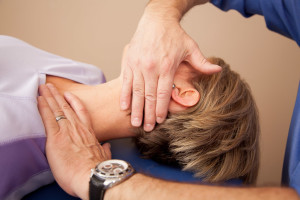
©Copyright 2020 Walt Fritz, PT, and the Pain Relief Center
